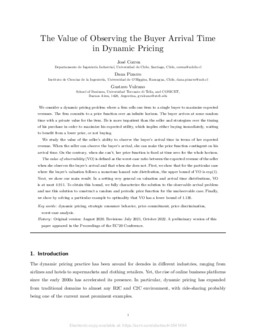The Value of Observing the Buyer Arrival Time in Dynamic Pricing

View/
Metadata
Show full item recordAuthor/s:
Vulcano, Gustavo
Correa, José
Pizarro, Dana
Date:
2020Abstract
We consider a dynamic pricing problem where a firm sells one item to a single buyer in order to maximize expected revenues. The firm commits to a price function over an infinite horizon. The buyer arrives at some random time with a private value for the item. He is more impatient than the seller and strategizes the time of his purchase in order to maximize his expected utility, which implies either buying immediately or waiting to benefit from a lower price.
We study how important is to observe the buyer arrival time in terms of the seller's expected revenue. When the seller can observe the arrival of the buyer, she can make the price function contingent on his arrival time. On the contrary, when the seller cannot observe the arrival, her price function is fixed at time zero for the whole horizon.
The value of observability (VO) is defined as the worst case ratio between the expected revenue of the seller when she observes the buyer's arrival and that when she does not. First, we show that for the particular case where the buyer's valuation follows a monotone hazard rate distribution, the upper bound is e, and it is tight. Next, we show our main result: In a very general setting about valuation and arrival time distributions, the value of observability is at most 4.911. To obtain this bound we fully characterize the observable arrival setting and use this solution to construct a random and periodic price function for the unobservable case. Finally, we show by solving a particular example to optimality that VO has a lower bound of 1.017.
Este documento es una versión del artículo publicado en Management Science (ahead of print)
